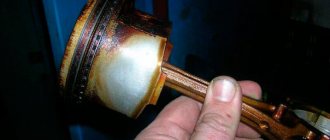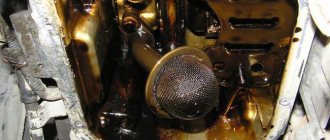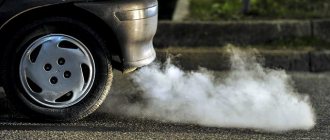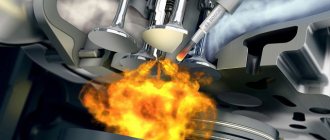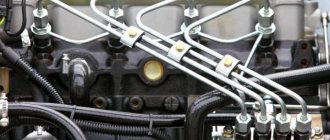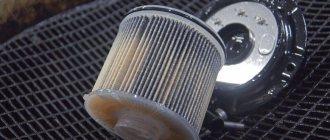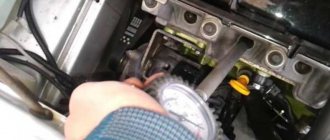Despite the presence of effective detergents in modern motor oils, the internal surfaces are still covered with a hard coating. The more time the engine runs, the stronger the slag deposits on its walls.
Coke (carbon deposits) on valves
Gradually, the thickness of the layer increases so much that the oil channels can become clogged. Another problem is the moving control and sealing elements: valves and piston rings.
If there is a sufficient (in a negative sense) layer of harmful deposits, the moving elements may jam. In this case, either the tightness will be broken, or on the contrary: stuck valves will not be able to perform their function as a gas flow regulator.
Engines running on heavy fuel are especially susceptible to this problem. Decarbonization of a diesel engine is performed more often than a gasoline engine.
How to decarbonize an engine with your own hands?
Information about cleaning the engine from carbon deposits (otherwise known as decoking) will be useful to those car enthusiasts who constantly operate one car for a long time and try to maintain it themselves. This procedure is, rather, preventive in nature, although in some cases it allows you to revive the power unit and extend the mileage before major repairs by 5–20 thousand km. How to decarbonize an engine with your own hands and what means are used for this, read in this publication.
Where does carbon deposits come from and where does it accumulate?
The cleaning procedure is not a panacea and does not always help, and sometimes gives the exact opposite effect. To use the technique correctly and on time, you need to understand the reason for the formation of deposits and the consequences of this phenomenon.
The cylinder-piston (CPG) and valve group of an internal combustion engine operates under difficult conditions - at high pressure and temperature. Over time, the rubbing surfaces of the parts wear out, and the seals lose their tightness, which is why engine oil begins to penetrate into the combustion chambers. The combustion conditions of the air-fuel mixture worsen as the lubricant burns out and forms a hard deposit on all accessible surfaces:
- piston skirts and chamber walls - first of all;
- side surfaces of the pistons in contact with the cylinder walls;
- the front planes of the valves and their internal surfaces adjacent to the seats;
- grooves for piston rings and holes for draining liquid lubricant (located deep in the groove of the oil scraper ring).
At the same time, the electrodes of the spark plugs become covered with soot, which reduces the quality of spark formation.
When the amount of lubricant penetrating inside the cylinder becomes critical, black coke clogs all possible cracks and holes. Because of this, the rings get stuck in the grooves (in the jargon they lie), causing the actual compression in the cylinders to drop by 50-90%. A valve that is burnt on the seat side will not close hermetically, and then the compression pressure will drop completely to zero - the cylinder will completely fail. The consequences can be prevented if the engine is decarbonized in time.
How and why does the so-called “coke” deposition occur?
Important: The main “supplier” of the problem is engine oil.
Let's immediately dispel some misconceptions. For some reason, it is generally accepted that slag deposits are possible only on old cars, and they are inherited.
Indeed, modern diesel fuel is cleaner (we reject unscrupulous gas stations, since this is not a systemic problem).
And synthetic oil does not contain a hydrocarbon base, which tends to separate from the composition and stick to the walls of mechanisms. However, the problem of hard deposits is equally inherent in modern power plants.
Causes of coke formation
- technology has become more precise: there are microscopic gaps between the parts of modern mechanisms that are easily clogged;
- engine operation (even diesel) is associated with high temperatures: an ideal environment for precipitation to stick;
Oil deposits on the shaft journals and housing - the intensity of work has increased: the lubricant is susceptible to separation, individual fractions easily become slag.
In diesel engines, the situation is aggravated by the presence of soot. This is a unique substance: it can be as small as desired, but the dry component does not dissolve in liquid.
When the piston system operates, soot particles enter the ring gaps and are retained in the cavities. Then heated oil gets there, which evaporates on the hot surface of the piston (we note right away that this is possible if the oil scraper rings lose their tightness).
A mixture of hot grease with solid soot particles is the strongest cement. It instantly deposits on the metal and forms a layer of real varnish.
Carbon deposits on the piston and rings
Of course, in this state the rings do not work. Compression and traction disappear, fuel consumption increases. And the saddest thing is that the problem of coking is growing exponentially. Loaded oil scraper rings allow more and more oil into the hot zone, and the slag layer increases.
The same picture is observed in the timing system. Valves (especially exhaust valves) also operate under intense temperature conditions. If there is motor oil in the cylinders (and we know that it gets there when the rings become coked), then again, together with the soot of the exhaust gases, a dense mass is formed, which over time turns into stone.
Coked engine valves
Another problem that requires diesel decarbonization is incomplete combustion of fuel. During operation, light fractions evaporate and burn, and heavy sediment concentrates in the cavities. Mixing with soot and oil, these compounds again form a layer of slag, which becomes more and more monolithic over time.
Consequences of soot
- Violation of the tightness of the piston rings, valve mechanism;
- The so-called “bedding” of moving elements;
- Reducing the volume of the combustion chamber: hence the loss of power;
- Carbon deposits on the upper arch of the cylinder can lead to untimely ignition of the fuel;
- The biggest problem is the malfunction of the lubrication system.
More about this:
The flow area of the oil channels is reduced: the consequences require no comment. Vibrations may cause small pieces of slag to fall off the walls. These elements can clog the same oil lines and damage various sensors.
When to decarbonize the engine?
The procedure gives a positive result if performed in a timely manner. You can’t delay it too much - you’ll just waste your money, because chemicals are not cheap. When decarbonization becomes useless:
- When driving for a long time with high oil consumption. If the engine “devours” 1 liter of lubricant per 1000 km or more, and you do not take any measures for 2–4 months, then get ready to make major repairs. The carbon deposits will clog the rings and oil drain holes so much that chemicals will not help, only mechanical cleaning.
- If compression in one or two cylinders has dropped to zero. This indicates burnt valves that the cleaner will not pick up.
- If noise or knocking occurs in the engine, requiring immediate replacement of parts.
You can perform decoking at your own risk, but with the symptoms listed, the chances of success are extremely low. Sometimes the opposite effect is observed - after cleaning, the compression in the engine drops and further driving becomes impossible, the engine loses a lot of power.
The reason for the phenomenon is the same carbon deposits. By covering all accessible surfaces, the coke begins to serve as a seal instead of the piston rings and, together with the lubricant, creates increased pressure in the chamber, sufficient to ignite the fuel mixture (so-called oil compression). After cleaning, the seal deposit disappears, and the pressure in the cylinders drops due to wear of the CPG elements. The motor refuses to work.
Practice shows that a special liquid for engine decarbonization should be used at a consumption of engine lubricant of 0.3–0.5 liters per 1 thousand kilometers. At this moment, intensive carbon deposits begin, but irreversible consequences have not yet occurred. If the culprits of the oil burn are valve seals, then after the procedure they can be changed and driven over 20 thousand km, provided that the CPG is in satisfactory condition.
Selecting a cleaning product
In car stores and markets you can find a wide variety of chemicals that are declared by manufacturers as effective cleaners of coke from power unit parts. Which of them are used most often and have earned a positive reputation:
The first 2 drugs are liquid in aerosol packaging with a capacity of 220 and 300 ml, respectively, pumped into cylinders through a tube. The remaining two products are poured in using a syringe. As a rule, one package - a can or bottle - is enough to service one four-cylinder engine with a working volume of up to 1.6 liters. For higher power engines with 6–12 cylinders, 2–3 tanks will be needed.
A few words about the best way to clean the engine. The undisputed leader is considered to be Mitsubishi Shumma, tested in practice by many master mechanics. There is only one drawback - the price of the drug is too high (about 30 USD per can). An alternative is GZox aerosol, which shows similar results at half the cost. Liquids BJ-211 and Lavr close the list of the best cleaners present on the automotive chemicals market.
Advice. You should not use old “old-fashioned” methods to decarbonize the engine of a modern car, pouring a mixture of acetone with solvent (kerosene) and other ineffective liquids into the cylinders. They act too slowly and do not dissolve carbon deposits well.
Decarbonization instructions
When warming up the power unit before cleaning, it is worth pouring a flushing compound into the crankcase - “five minutes” in order to remove dirt from the oil channels as much as possible. You should also measure the compression on a hot engine in advance, this will help you see the result before and after decarbonization.
Perform further actions in this order:
- Carefully read the instructions on the cleaning product packaging and find out how much liquid needs to be poured into each cylinder of your engine.
- Remove the spark plugs and clean them thoroughly with a metal brush, rinse with gasoline and blow out.
- While turning the drive wheel by hand with 5th gear engaged, set all pistons to the middle position, measuring the depth with a long screwdriver.
- Lowering the tube one by one into the spark plug holes, fill the cylinders with aerosol from a spray can. Decarbonization of the Lavr engine is done using a syringe (included with the drug).
- Screw the spark plugs back in without tightening them all the way.
- Leave for 8–15 hours, periodically moving the crankshaft by turning the wheel. The goal is to help fluid penetrate between the piston rings.
After the time specified in the instructions has passed, unscrew the spark plugs again and try to pump out the dissolved dirt from the cylinders with a syringe, and then blow it thoroughly with a compressor. The better you can clean out the remaining coke, the faster the engine will start.
Install the old spark plugs and start the engine without increasing the speed above 1500 rpm. Let it warm up and “spit out” pieces of carbon deposits through the exhaust tract. After 10–15 minutes of engine operation, when the smoke from the exhaust decreases, return the lambda probes to their place and begin replacing the engine lubricant.
Screw in new spark plugs last, after cleaning the power unit and changing the oil. Before installing spark plugs, re-measure the compression and make sure that the measure has a positive effect. If the result is negative, begin preparations for disassembling and overhauling the motor.
Decarbonization of a diesel engine differs in the method of filling the cylinders with a chemical. Since there are no spark plugs, the fluid is poured through the injector holes. The latter will have to be dismantled after first releasing the fuel pressure in the system and turning off the pump.
How to decarbonize a diesel engine?
Academically, there are three ways to remove any solid deposits:
Direct impact method
This could be a simple scraping or stripping. Nobody canceled the sandblasting machine. However, these methods have serious drawbacks.
- Engine disassembly required. In fact - a major overhaul.
- The method removes a thin layer of metal, violating the adjusted geometry.
This does not mean that the method is off the agenda. Mechanical processing is used, but it is better to do it in bench conditions, with control of geometric parameters.
Mechanical method with ultrasound
This method is relatively safe for the parts being cleaned. Only the slag deposit crumbles, the geometry is not violated, and the gaps do not become larger. However, installations for generating ultrasound of such power are quite expensive.
It is not practical to keep such a device in a personal garage. The cost can be compared to the decarbonization of diesel engine rings, performed hundreds of times (with payment for services).
In addition, the destroyed plaque has heterogeneous fragments. All this mechanical debris remains inside the case and can cause a lot of trouble.
Chemical, using special liquids
Perhaps the most popular technique. 20-30 years ago engines were decoked in exactly this way.
Let's look at it in more detail: The advantages of working with liquids are that they do not harm metal parts.
note
Plastic sensors, gaskets and rubber seals can be completely destroyed.
Another plus: varnish deposits are completely dissolved, they can be removed through the drain hole, or they themselves fly out into the exhaust pipe.
But the main advantage is local application. To introduce a solvent liquid, complete disassembly of the engine, much less its dismantling, is not required. It is enough to gain access to the hole (for example, unscrew the spark plugs), or remove the valve cover.
In some cases, drugs are added to motor oil or fuel. However, it is this technique (dilution of technical fluids) that causes the most controversy.
Correct engine decarbonization, means, methods, tricks.
Hi all. The topic of today's article is proper engine decarbonization. The article discusses popular decarbonization methods and analyzes the effectiveness of each of them.
A little theory.
In internal combustion engines, 3 rings are installed on the piston - 2 compression rings (they provide compression of the mixture in the cylinder) and one oil scraper ring. When the engine operates during fuel combustion, carbon deposits are deposited on the surfaces of the piston and combustion chamber. This occurs especially intensively in winter and during urban traffic cycles.
Some of this carbon deposits inevitably fall on the surface of the rings and clog them. Accordingly, the rings become less mobile and better allow the mixture to pass into the crankcase. As a result, engine power drops, fuel consumption increases, and the oil darkens faster, all this is a consequence of decreased compression...
Decarbonization - removal of carbon deposits from the surfaces of compression and oil scraper rings....
What is decarbonization?
First of all, you should understand that the decarbonization procedure is not a restoration or a major overhaul of the engine, but routine maintenance that allows you to maintain good working condition. In other words, this is an opportunity to postpone major engine repairs for a long time.
The essence of the procedure is to remove carbon deposits that form as a result of various unfavorable factors. Deposits adhere to the piston rings, and this has a negative effect on engine performance. In some cases, this leads to the car stopping to start.
Many experts advise contacting a car service to do this work, rather than trying to do everything yourself. The main problem is removing diesel injectors. It is worth remembering that often, unprofessional independent intervention will quickly lead to a complete overhaul.
We improve our qualifications or what regular engine decarbonization with auto chemicals gives
In order to get a qualified answer, you need to figure out what decoking of piston rings does without disassembling the car engine:
- Restores normal compression levels in the combustion chamber. A decrease in compression pressure in the cylinder occurs for various reasons: wear of the rings, their coking or carbon deposits on the valve seats.
- Reduces oil consumption.
- Reduces fuel consumption.
In advanced cases, the need for decarbonization will be indicated by a specific exhaust color (black or gray), glow ignition, a general decrease in power and difficulty starting the unit. The procedure should not be considered as a preventive one - fuel additives of various classes have been developed for this purpose. The operation is prescribed after the fact - when a set of symptoms appears. It is not recommended to neglect it, otherwise the following will occur:
- The occurrence of rings, when they are embedded in the grooves and lose their mobility. This leads to an increase in gaps, which causes a critical drop in compression and an increased appetite for oil.
- Accumulation of carbon deposits under the ring, leading to the latter being squeezed out of the groove. In such a situation, scoring occurs on the cylinder walls.
- Reducing the flow area of the channels for the valves, which will subsequently cause their loose fit and, as a result, burnout.
ICE decarbonization: available options
Today there are several ways to decarbonize a diesel or gasoline engine:
- adding an additive to engine oil;
- additive in diesel fuel or gasoline;
- pouring the composition into the cylinders directly;
Each of the engine decarbonization methods is conventionally divided into “soft” and “hard” based on the strength of its impact on deposits, and also has a number of individual advantages and disadvantages. Individual solutions can only be considered a preventive measure, and not a repair and restoration procedure.
Additive to engine oil for cleaning piston rings
This cleaning method is gentle and is aimed at removing carbon deposits only from the piston rings. The cleaning composition is intended for flushing the lubrication system of the internal combustion engine, but also affects the lower oil scraper rings, which get stuck quite often.
This product is an oil system flushing fluid with the addition of cleaning components to remove carbon deposits from piston rings. The product is poured into the engine oil, then the car is driven for up to 200 km, after which the oil and oil filter are changed.
The disadvantages of this method include the fact that you cannot turn or load the motor during cleaning. The second nuance is to shorten the interval for the next oil change not according to the regulations, but earlier by 5-6 thousand km. There are also compounds on the market that do not require an oil change at all after adding an additive, but their use in this way remains questionable.
Another disadvantage is that flushing with oil does not clean the combustion chamber and valves of carbon deposits and deposits. Based on this, this method can be attributed exclusively to prevention, which can be implemented at certain intervals with minor coking of the internal combustion engine.
Flushing into fuel for decoking of internal combustion engines
When using this method, engine decarbonization occurs while driving a car. The main advantages include the simplicity of the solution, relative “softness” and the ability to operate the motor without restrictions. Also, with this decarbonization method there is no need to change the engine oil.
The decarbonizing composition is poured into the fuel tank. Next, the product, together with the fuel, ends up in the combustion chamber. During operation of the unit, the components of the composition gradually soften carbon deposits and varnish deposits, and then burn out along with them. As a result, carbon deposits from the combustion chamber are removed through the engine exhaust system along with the exhaust gases.
We also recommend reading the article about additives in diesel fuel to prevent waxing and freezing of diesel fuel in fuel lines. From this article you can learn about how anti-gels work and what additives need to be added to diesel fuel in winter.
The main task of decoking is cleaning the oil scraper rings. The fuel additive allows it to act on deposits and varnish for a long time, since the addition of 50 liters of diesel fuel will allow for constant impact over about 450 km. Manufacturers promise decarbonization of rings, increased compression, cleaning of the combustion chamber and valves, as well as the formation of a protective film on rubbing vapors. The film reduces the temperature on the surface of the parts. Such protection should prevent further carbon formation.
As practice shows, in the case of severe contamination, this solution is not always effective, and questions remain regarding the effect of the additive on the sensitive fuel equipment of a diesel engine. We can conclude that in the case of serious contamination and malfunctions of the internal combustion engine, such a method may not give the desired effect.
Technology for decarbonizing car engine piston rings without disassembling the unit
Decarbonization can be done in two ways: mechanical and chemical. The first option is very labor-intensive and is performed exclusively on a disassembled motor. If carried out, it is combined with a major overhaul. The second way is based on the use of various chemicals.
How it is produced
Decarbonizing the engine with chemicals gives quick results. The principle of its implementation is the same regardless of the type of composition used. Detailed instructions include the following transitions:
- Warm up the engine.
- Unscrew the spark plugs.
- Move the pistons to the middle position.
- Pour the decoking mixture into the cylinders.
- Wait a while (the duration of the process depends on the type of auto chemical used).
- Pump out the remaining liquid from the “pots”.
Decarbonizing composition of branded production
The assortment of a large auto retail chain offers a fairly large number of detergents for removing carbon deposits. They propose to remove and dissolve coke in the combustion chamber over different periods of time. The bill for payment is also different - there are budget drugs, there are also expensive ones.
A qualified seller will definitely ask about the desired degree of aggressiveness of the product. It all depends on the mileage and the degree of neglect of the closed chamber. There are soft and rough compositions. When choosing a composition, you should focus on the top representatives of the niche:
- Misubishi SHUMMA - rough (1,500 rubles).
- XADO Verylube – hard (800 rubles).
- Greenol REANIMATOR – coarse (900 rubles).
- GZox – soft (500 rubles).
- Kangaroo ICC 300 – soft (400 rubles).
Before purchasing, you need to familiarize yourself with the features of the engine, read reviews about decoking of piston rings of a certain engine model without disassembling it, and carefully study the instructions. For example, GZox is not recommended to come into contact with alusil coating, which is often applied to the cylinders of units of modern foreign cars.
Homemade decoking preparations
Alternative functionality can be provided by household or pharmacy products at an affordable price. An experimental popular base has been developed regarding their use. Photo reports show that well-chosen proportions allow you to achieve excellent cleaning results.
Solvent decarbonization of the engine
The solvent is a light hydrocarbon. It is obtained both from coal and gas, and from oil. The most aggressive properties are coal-based nefras, which has a yellowish tint. However, clear liquids obtained from petroleum products also clean well.
Practice shows that 20 cubes of solvent per cylinder is enough in cases where compression is normal, but the engine is already starting to eat up oil. The portion is poured for 0.5 hours. After filling, you immediately need to turn the crankshaft 20-40 degrees in one direction, then in the other, so that the drug gets to the rings faster.
Compression problems are more serious and can be corrected with continued treatment. It is enough to inject 100 ml per cylinder and leave the mixture for 4-5 hours. The presence of liquid in the “pots” must be monitored and topped up, since it eventually goes into the crankcase.
Engine decarbonization with kerosene
Kerosene liquid is colorless and is obtained by direct distillation from petroleum. Coke cleaning alone is ineffective. A mixture of kerosene and acetone in a 1:1 ratio has more aggressive properties. 50 ml of the composition is poured into one cylinder. Staying time – 12 hours.
Decarbonization with kerosene does not produce the desired effect on running engines due to its low solvent properties. Reviews compare this method with soft branded products and are prescribed at the initial stage of oil burns and loss of compression.
Dissolving carbon deposits with dimexide
Dimethyl sulfoxide is a pharmaceutical anti-inflammatory drug. Sold in tubes of 100 ml. Price – about 50 rubles. In fact, it turned out to be a strong solvent of various deposits. The drug is prescribed for use on engines with an impressive amount of coke in the piston grooves.
This product should be used with caution. According to reviews of the drug:
- Crystallizes at temperatures below 18.5°C.
- Peels paint.
- Destroys plastics.
If there are no plastic elements in the power plant, the enamel has been removed from the pan and dipstick, the work is carried out in a heated garage or during the hot season, and the instructions on how to properly flush the engine with dimexide are followed, then there is nothing to fear.
Chemical method
This is the simplest and most popular method for decarbonizing equipment. It is performed using special liquids that are added to the tank. When the car is running, a chemical liquid is supplied into the combustion chamber together with fuel. In this case, the removal and combustion of all deposits occurs during operation.
Removal of combustion products is carried out through a special gas exhaust system. That is, there is no need to disassemble the diesel engine. This makes the work of car enthusiasts much easier.
According to reviews from car owners, this method has no disadvantages. The advantages include simplicity, accessibility and cost-effectiveness.
Some car enthusiasts suggest using ordinary kerosene instead of a specially designed solution. Professionals are categorically against this. When using it, you can achieve the opposite effect, and then a complete engine repair will be required.
Total
The purpose of decoking measures is to clean the combustion chamber of carbon deposits. Relevant for low compression, increased oil consumption and increased fuel consumption. The essence of the procedures is to pour the composition into the cylinders and give it time to dissolve the deposits.
The chemical cleaning method is preferable because it does not require disassembling the engine. You can use both branded decarbonizers and homemade ones. Among the traditional methods are decarbonization with solvent, kerosene and acetone and dimexide. Dimethyl sulfoxide has the most aggressive properties.
Diesel engine decarbonization
For decarbonization of diesel power units, the same means are used as for gasoline ones - LAVR’s assortment includes five highly effective drugs, three liquid and two aerosol. We have already talked in more detail about which decarbonizer to choose - you can read the article by following the link. Today we will briefly describe each composition so that you can choose the right one for your diesel engine.
- LAVR COMPLEX is a foam decarbonizer that perfectly copes with restoring the car's dynamics and also cleanses contaminants inside the combustion chamber. Thick foam does an excellent job of cleaning even complex power units - boxer and V-shaped.
- LAVR EXPRESS is a foam composition for preventing the formation of deposits inside engines, which by their design are prone to accelerated formation of soot. In 15 minutes, the product effectively combats increased oil consumption, and also equalizes the pressure inside the cylinders of a diesel engine if it deviates from the norm by no more than 10%.
- ML202 is a classic of the genre, this decarbonizer copes with excess oil consumption and deposits inside diesel engines, and is also completely safe for rubber seals, painted parts and anti-friction coatings. The exposure time of the drug is from 1 to 12 hours.
- ML203 is an enhanced formula that is designed to speed up the procedure and increase its effectiveness. This decarbonization is capable of normalizing pressure and removing even persistent tar and carbon deposits from a diesel engine. ML203 Truck is the same product, but for trucks whose engines are often used in harsh conditions. The exposure time of the compositions is from 60 to 90 minutes.
- ML204 – decarbonizer with enhanced penetrating ability. The procedure involves removing the oil pan and additionally flushing the engine. The composition is designed specifically to solve the most serious problems of contamination of power units. Exposure time 60 minutes.
